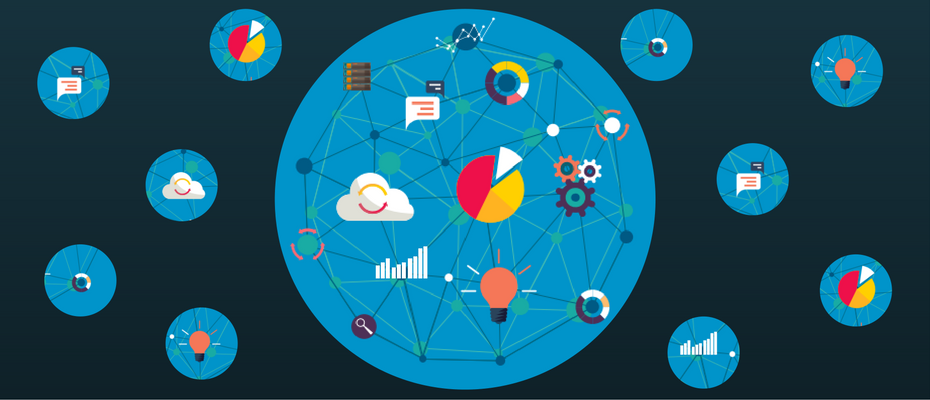Latest Posts

A recent Experian analysis shows that about 2.5 million consumers will have a foreclosure, short sale or bankruptcy fall off their credit report between June 2016 and June 2017 — with 68% of these consumers scoring in the near-prime or high credit segments. Additional highlights include: Nearly 29% of those who short-sold between 2007 and 2010 have opened a new mortgage. Delinquencies for this group are below the national average for bankcard and auto loan payments. More than 12% of those who foreclosed now have boomeranged (opened new mortgages). With millions of borrowers potentially re-entering the housing market, the trends are promising for both the mortgage seeker and the lender. Want to know more?

It’s been a wild ride for the financial services industry over the past eight years. After the mortgage meltdown, the Great Recession and a stagnant economy … well, one could say the country had seen better days. Did you watch The Big Short last winter? It all came crumbling down. And then President Barack Obama entered the scene. Change was needed. More oversight introduced. Suddenly, we had the Affordable Care Act, the Dodd-Frank Wall Street Reform Act and the creation of the Consumer Financial Protection Bureau (CFPB). Taxes were raised on the country’s highest earners for the first time since the late-1990s. In essence, the pendulum swung hard and fast to a new era of tightened and rigorous regulation. Fast forward to present day and we find ourselves on the cusp of transitioning to new leadership for the country. A new president, new cabinet, new leaders in Congress. What will it all mean for financial services regulations? It’s helpful to initially take a look back at the key regulations that have been introduced over the past eight years. Mortgage Reform: Long gone are the days of obtaining a quick mortgage. New rules have required loan originators to verify and document the consumer’s income and assets, including employment status (if relied upon), existing debt obligations, mortgage-related obligations, alimony and child support. The CFPB has also expanded foreclosure protections for struggling borrowers and homeowners. Maintaining the health of the mortgage industry is important for the entire country, and updated rules have enhanced the safety and transparency of the mortgage market. Home values have largely recovered from the darkest days, but some question whether the underwriting criteria have become too strict. Combatting Fraud: The latest cyber-attack trends and threats come fast and furious. Thus, regulators are largely addressing the challenge by expecting banks to adhere to world-class standards from organizations such as the National Institute of Standards and Technology (NIST). The Federal Trade Commission (FTC) and the National Credit Union Administration (NCUA) implemented the Red Flags Rule in November 2008. It requires institutions to establish policies and procedures to identify and recognize red flags — i.e., patterns, practices or specific activities that indicate the possible existence of identity theft — that occur during account-opening activities, existing account maintenance and new activity on an account that has been inactive for two or more years. Loss Forecasting: The Dodd-Frank Act Requires the Federal Reserve to conduct an annual stress test of bank holding companies (BHCs), savings and loan holding companies, state member banks, and nonbank financial institutions. In October 2012, the Fed Board adopted the Comprehensive Capital Analysis and Review (CCAR) rules. This requires banks with assets of $50 billion or more to submit to an annual review centered on a supervisory stress test to gauge capital adequacy. In January 2016, Dodd-Frank Act Stress Testing (DFAST) was introduced, requiring bank holding companies with assets of $10 billion or more to conduct separate annual stress tests known as “company-run tests” using economic scenarios. Every year regulators expect to see continued improvement in stress-testing models and capital-planning approaches as they raise the bar on what constitutes an acceptable practice. CFPB: No longer the new kids on the block, the CFPB has transitioned to an entity that has its tentacles into every aspect of consumer financial products. Mortgage lending was one of their first pursuits, but they have since dug into “ability-to-pay underwriting” and servicing standards for auto loans, credit cards and add-on products sold through third-party vendors. Now they are looking into will likely be the next “bubble,” – student lending – and educating themselves about online marketplace lending. Data Quality: Expectations related to data quality, risk analytics, and regulatory reporting have risen dramatically since the financial downturn. Inaccuracy in data is costly and harmful, slows down the industry, and creates frustration. In short, it’s bad for consumers and the industry. It’s no secret that financial institutions rely on the accuracy of credit data to make the most informed decisions about the creditworthiness of their customers. With intense scrutiny in this area, many financial institutions have created robust teams to handle and manage requirements and implement sound policies surrounding data accuracy. --- This is merely a sliver of the multiple regulations introduced and strengthened over the past eight years. Is there a belief that the regulatory pendulum might take a swing to other side with new leadership? Unlikely. The agenda for 2017 largely centers on the need to improve debt collections practices, enhance access to credit for struggling Americans, and the need for ongoing monitoring of the fintech space. Only time will tell, but one thing is certain. Anyone involved in financial services needs to keep a watchful eye on the ever-evolving world of regulation and Washington.

Late last year, our Third Annual Data Breach Industry Forecast predicted cybercriminals would continue to focus their attacks on healthcare institutions, inspired by the knowledge that the black market value of medical records continues to surpass the value of credit card numbers. Industry experts we interviewed also predicted employee missteps would be a source of healthcare breaches. Entering the final quarter of 2016, our prediction is playing out in the numbers; nearly half of all consumers affected by a data breach so far this year had their personal information exposed through a healthcare-related incident, according to information compiled by the Identity Theft Resource Center. In the first three quarters of the year, 256 medical and healthcare data breaches exposed more than 13.5 million records, the highest number of any sector the ITRC tracks. Records compromised in a healthcare breach accounted for 47.2 percent of all affected records in 2016. The healthcare sector has been a hotbed of attacks throughout the year, largely due to the continued value of medical records sold on the dark web. These records can be used for far more than just filing fraudulent medical claims. One lucrative use is filing fraudulent tax returns. CNBC reported the IRS expects, and has been bracing for, an increase in tax fraud linked to the high number of medical breaches this year. It’s easy to understand why medical records can be so profitable for hackers. While financial accounts such as credit cards may contain a limited amount of personal information, medical records are much more comprehensive. Typically, they contain a wealth of information far beyond mere account numbers. In addition to names, addresses and birth dates, medical records often contain Social Security numbers, which healthcare providers may use as patient identifiers. The employee factor Many of the mega-breaches of 2015 occurred through digital routes that the average consumer would find downright arcane. In 2016, we’ve seen an increase in smaller attacks with mundane origins such as stolen hardware, poorly secured employee email accounts or phishing attacks. Consider these examples reported in the HIPAA Journal: Four staff email accounts were compromised in a phishing attack on employees at City of Hope Hospital in California. To put it more bluntly, four hospital employees fell for scam emails and the result was, as ITRC reports, the exposure of more than 1,000 patient records. More than 200,000 patients of Premier Healthcare in Bloomington, Indiana, received notification letters after a password-protected but unencrypted laptop was stolen from the hospital’s billing department. A St. Louis, Missouri, not-for-profit healthcare system, BJC Healthcare, had to notify more than 2,300 patients their information was exposed after an employee mistakenly sent an email containing protected information to another medical organization. For healthcare institutions, the takeaway from 2016 should be the need to remain vigilant and proactive regarding the many ways in which data breaches can occur. While 2015 was the year of healthcare mega-breaches, 2016 has seen the emergence of smaller breaches that still have the potential to cause significant harm to organizations and patients. Learn more about our Data Breach solutions

U.S. Communities national contract awarded to Experian to use their data and analytic solutions in order to enable state and local government agencies to help consumers and better serve their communities for the future.

$1.3 trillion. 41.1 million Americans. $31,590. These are the growing numbers associated with student loan debt in the United States: $1.3 trillion in outstanding student loans, spread across 41.1 million people, who are leaving college with an average balance of $31,590. The numbers are staggering, and for the first time student loan debt is playing a prominent role in a presidential election. For all of their differences, presidential nominees Hillary Clinton and Donald Trump seem to agree on one thing: student loan debt is a crushing burden. Both candidates have proposed solutions for student lending. Clinton’s “New College Compact” would allow borrowers to refinance their student loans at current rates available to students taking out new loans. She also wants to reduce interest rates on new student loans, and make it easier for borrowers to enroll in income-driven repayment programs that would cap monthly payments at 10 percent of discretionary income. Trump proposes giving more oversight to colleges to decide whether to grant loans to students based on their prospective major. The plan would also give private banks oversight over government-backed student loans—reversing a 2010 decision under President Obama to make the federal government the lender. Neither candidate, however, has outlined a solution for taming growing tuition costs. Tuition expenses are up 1,225 percent over the past 36 years, outpacing medical costs (634 percent rise) and the consumer price index (279 percent) over the same period, according to the Bureau of Labor Statistics. So it’s not surprising an Experian study shows the student loan rate has grown five percent in the past three years. What is surprising is the number of people and the average age of those people holding student loans. Experian found: 20 percent of people with a credit file hold a student loan that is being repaid or deferred. The average age of a consumer with a student loan is 37, with an average income of $47,200 compared to 53.8 and an average income is $44,500 for consumers without a student loan. The average age of a consumer with at least one deferred student loan is 32.7 with an average income of $32,900 compared to 38.7 and an average income of $53,200 for consumers with at least one non-deferred student loan. Candidate proposals aside, one thing is certain: student loan debt has a very real impact on the daily lives of people, many of whom have delayed buying homes, starting families, and saving for retirement. Until policymakers find a way to address bloated tuitions and student debt, it will take many longer to realize their dreams.

Call if you need to, but protect yourself from TCPA exposure first. Follow these steps when creating your dialing strategy: Obtain customer consent Determine if the number is attached to a landline or a wireless device Verify ownership Scrub your database Calling cell numbers can be a risky business, so be sure to set the proper workflow in motion to remain compliant. >>Learn more

Businesses believe that 23% of their customer or prospect data is inaccurate. Since 84% of companies have a loyalty or customer engagement program in place, poor data is a costly issue. The unfortunate reality is that 74% of companies have encountered problems with these programs — and 12% of revenue is believed to be wasted as a result. Is your loyalty program suffering from poor data? There is a cure. Think of data quality as preventative medicine for a costly and entirely avoidable illness. >>Learn more

Since 1948, International Credit Union Day – a time to recognize the credit union movement – has been celebrated the third Thursday of October. The day is the perfect time to remind your members and consumers about all of the services and benefits your credit union offers. This year’s theme, “The Authentic Difference,” celebrates what makes credit unions stand out. Here are 10 reasons CUs deserve a spotlight: Credit unions are non-profit cooperatives, owned and operated by its members. That means they emphasize consumer value to more than 217 million members worldwide. Profits go back to members in the form of reduced fees, higher savings rates and lower loan rates. Personal relationships are key. Credit unions pride themselves on developing relationships with their members, and CUs are typically staffed by friendly reps who know customers by name. Checking accounts are free. Roughly 80 percent of credit unions offer free checking accounts, compared to less than 50 percent of banks, according to economic research firm Moebs Services. Few ATM fees. Many credit union customers are able to avoid ATM fees because CUs typically give them access to a large network of ATMs by sharing branches and other resources. Savings rates are above average. Because credit unions don't have to pay dividends to shareholders and are exempt from federal taxes they can offer high rates on saving accounts. The average credit union offers CD, money market, and savings rates well above the national banking rates average. Lower interest rates. Credit unions offer lower interest rates on some loans. The difference between banks and credit unions was greatest in car-loan interest rates, according to a September report by SNL Financial. The average 36-month used-car loan interest rate offered by CUs was 2.67 percent compared to 4.45 percent for banks. For new-car loans, CUs offered an average interest rate for 48 months of 2.60 percent compared to 3.94 percent for banks. Invested in the community. A credit union’s core values are focused on its members and the communities where they live and work. Many provide financial education and outreach to consumers. It’s easier to get credit. CUs don’t have to abide by loan restrictions and qualifications mandated by a corporate office, so they have more flexibility to make loans when possible. Small-business support: CUs may know borrowers and are able to take into account intangibles like community reputation and accountability. Also, they understand the value to the community of a small business, its market and credit needs. Joining is easy. Many credit unions base eligibility simply on where you live, instead of restricting membership to a particular employer. Since expanding eligibility, credit union membership has grown by about two percent a year for the past decade.

Much has been written about Millennials over the past few years, and many continue to speculate on how this now largest living generation will live, age and ultimately change the world. Will they still aspire to achieve the “American Dream” of education, home and raising a family? Do they wish for something different? Or has the “Dream” simply been delayed with so many individuals saddled with record-high student loan debt? According to a recent study by Pew, for the first time in more than 130 years, adults ages 18 to 34 were slightly more likely to be living in their parents’ home than they were to be living with a spouse or partner in their own household. It’s no secret the median age of first marriage has risen steadily for decades. In fact, a growing share of young adults may be eschewing marriage altogether. Layer on the story that about half of young college graduates between the ages of 22 and 27 are said to be “underemployed”—working in a job that hasn’t historically required a college degree – and it’s clear if nothing else that the “American Dream” for many Millennials has been delayed. So what does this all mean for the world of homeownership? While some experts warn the homeownership rate will continue to decrease, others – like Freddie Mac – believe that sentiment is overly pessimistic. Freddie Mac Chief Economist Sean Becketti says, “The income and education gaps that are responsible for some of the differences may be narrowed or eliminated as the U.S. becomes a 'majority minority' country.” Mortgage interest rates are still near historic lows, but home prices are rising far faster than incomes, negating much of the savings from these low rates. Experian has taken the question a step further, diving into not just “Do Millennials want to buy homes” but “Can Millennials buy homes?” Using mortgage readiness underwriting criteria, the bureau took a large consumer sample and assessed Millennial mortgage readiness. Experian then worked with Freddie Mac to identify where these “ready” individuals had the best chance of finding homes. The two factors that had the strongest correlation on homeownership were income and being married. From a credit perspective, 33 percent of the sample had strong or moderate credit, while 50 percent had weak credit. While the 50 percent figure is startling, it is important to note 40 percent of that grouping consisted of individuals aged 18 to 26. They simply haven’t had enough time to build up their credit. Second, of the weak group, 31 percent were “near-moderate,” meaning their VantageScore® credit score is 601 to 660, so they are close to reaching a “ready” status. Overall, student debt and home price had a negative correlation on homeownership. In regards to regions, Millennials are most likely to live in places where they can make money, so urban hubs like Los Angeles, San Francisco, Chicago, Dallas, Houston, Boston, New York and DC currently serve as basecamp for this group. Still, when you factor in affordability, findings revealed the Greater New York, Houston and Miami areas would be good areas for sourcing Millennials who are mortgage ready and matching them to affordable inventory. Complete research findings can be accessed in the Experian-Freddie Mac co-hosted webinar, but overall signs indicate Millennials are increasingly becoming “mortgage ready” as they age, and will soon want to own their slice of the “American Dream.” Expect the Millennial homeownership rate of 34 percent to creep higher in the years to come. Brokers, lenders and realtors get ready.

When financial planners and tax advisors meet with clients to review their portfolios, chances are they don't go over their credit reports often. Maybe they never do. Kiplinger’s estimates less than half of professional financial advisors take the time to review credit reports with clients. But taking this step is critical to understanding a person’s complete financial situation and creating a realistic plan. Prepare for Future Opportunities Clients may have all the credit they need at the moment, but if their credit score is mediocre or low, they might end up paying for it in the future. Just when they want to refinance a loan, buy more insurance, apply for a dream job or buy a business, they may discover their credit score is an obstacle. Check for Errors Credit bureaus collect billions of data points from millions of businesses each year, and it’s important to check a credit report for accuracy. If there are errors in a client’s file, he or she may be unfairly penalized. Keep in mind that nearly every company checks credit reports to determine who to do business with. Potential employers, business partners and insurance companies give credit files a look before deciding whether or not to make an offer to a person. Awareness Mistakes aren't the only factor leading to a low credit score. Too many hard inquiries, a maxed-out credit card or a number of small loans that could be paid off all cost credit points. Reviewing a credit report is a great way to help clients see the real impact their habits have on their financial life, and they could realize a significant rise in their credit score with little effort. Stand Out in the Crowd Even if a person has an exceptional credit report, a financial or tax advisor will gain credibility by reviewing their information with them. Doing so demonstrates out-of-the-box thinking and concern for a person’s financial health. Let's see a robo-advisor do this. Financial professionals can easily and securely review their clients’ credit reports online. Ready to understand your client’s complete financial situation? Try out our online solution at no cost to you. Interested in integrating with your existing financial or tax planning software? Learn more about integration options with Experian’s API.

Millennials are coming of age and experiencing big life moments — college graduation, their first job, getting married and moving out. But what about buying ahome? Here are some things we know: Millennials are 75 million strong 75% say homeownership is a long-term goal Millennials are now the largest living generation. Are you equipped with the right strategies and tools to serve their lending needs? >>Webinar: Are Millenials Mortgage-Ready?

As we approach the one-year anniversary of the EMV liability shift, we have seen an increase in e-commerce fraud — to the tune of 15% higher than last year. Additional insights from Experian’s biannual analysis on e-commerce fraud include: 44% of e-commerce billing fraud came from Florida, California and New York* 52% of e-commerce shipping fraud came from Florida, New York and California* Miami, Fla., is the most dangerous city in the United States for e-commerce merchants* As fraudsters continue to perpetrate card-not-present fraud, ensure you are prepared. You’ll be thankful if fraudsters come calling. >> E-commerce Attack Rates

In this new Telephone Consumer Protection Act (TCPA) era, calling your customers isn’t a thing of the past. It’s still okay to reach out to your clients by phone, whether to offer a new product or collect on an overdue bill. But strict compliance with TCPA rules is critical for any business that contacts customers by phone. Some of the very best ways you can protect yourself from TCPA exposure is to follow four steps when creating your dialing strategy: Customer consent: It’s important to maintain and update your customers’ contact preferences and consent to call them. Simply having a phone number on an application isn’t sufficient. Companies are required to have written permission, such as “I consent to calling my cell phone when there’s a problem …” Remember, permission may only be granted by the party who subscribes to the cellular service or who regularly uses that cell phone number. Landline or wireless?: Your database should also include the phone type for the telephone numbers you have for your customers. The dialing rules differ depending on the phone type, so it’s critical to know the type of phone you are calling or texting. Verify ownership: Ownership of cell phones should especially be validated to ensure the number hasn’t been reassigned and that the person who gave consent still owns the phone. One call can be made to a reassigned number with no liability, assuming you have no knowledge the number has changed. Repeating the action could lead to fines from $500 to $1,500 per infraction. Scrub Your Database: Have practices in place to remove any confirmed reassigned phone numbers from your database. This will help to improve your right-party contact rate and save you from potential TCPA headaches. No one disagrees that calling cell numbers is a risky business, but it can be done if you set the proper workflow in motion. Click here to learn more about Experian solutions that will help to reduce your TCPA compliance risk.

Leasing continued its strong growth as the share of new vehicles leased jumped from 26.9% in Q2 2015 to a record high of 31.4% in Q2 2016. As vehicle prices continue to rise, used vehicle loans also set new records. The average used vehicle loan reached an all-time high of $19,101 in Q2 2016, up from $18,671 in Q2 2015. Used vehicle loans accounted for 55.6% of all vehicle loans in Q2 2016. Want to capitalize on this growth? Analytics can help you target borrowers who are creditworthy and in the market for an auto loan or lease. >>Video: Auto Acquisition Strategies

With the Oct. 3, 2016 compliance date upon us, many lenders continue to debate how they would like to solve for the Military Lending Act (MLA). With new enhancements, more protections have been granted to members of the military and their dependents when it comes to “consumer credit” products, specifically around the 36% cap on the MAPR. The key then becomes how to identify these individuals. At origination, how can the lender know if an individual is a member of the military, or a service member’s dependent? The answer, of course, lies in verification. Under the new Department of Defense (DOD) rule, lenders will have to check each credit applicant to confirm that they are not a service member, spouse, or the dependent of a service member. The final rule includes a “safe harbor” from liability for lenders who verify the MLA status of a consumer through a nationwide Credit Reporting Agency (CRA) or the DOD’s own database, known as the DMDC. Obviously, lenders will want to have this “safe harbor,” so the question becomes do you opt for the direct or indirect solution? The direct solution is to have the lender access the DMDC on their own. With this option, expected turnaround time is 24 hours for batch searches. The DMDC expects the volume of searches to their servers to increase from 220 million a week to 1.9 billion a week. For some, this feels like a more manual process, but it can be done. The indirect solution involves the CRA accessing the DMDC data on the lender’s behalf. In Experian’s case, this would translate into lenders seeing the MLA indicator on the credit report at point of origination or making a call out for just the MLA indicator. The process is integrated into the credit-pull cycle, so no manual effort is required on the lender’s end. MLA status is simply flagged. The rule also permits the consumer report to be obtained from a reseller that obtains such a report from a nationwide consumer reporting agency. Required data to perform a search includes full legal name, address, social security number and date of birth. This applies to both the credit report add-on and Experian’s standalone solutions. If any of this data is missing from the inquiry, Experian is unable to perform the MLA search. Credit card lenders have until Oct. 3, 2017 to adhere to the new standards, but all other applicable lenders must act now and build out their compliance standards and solutions. Direct or indirect? That is the question. To learn more about MLA or how Experian can help, visit our dedicated-MLA site.